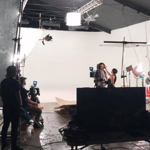In our latest interview, we chatted with ADG award winner Ethan Tobman, the production designer of Hulu’s limited series Pam & Tommy. The series pulls us back to the mid-90’s and tells the story of the whirlwind romance between Pamela Anderson (Lily James) and Tommy Lee (Sebastian Stan).
For the show, almost all of the interiors were completely custom built, including the lavish Malibu mansion where much of the series takes place.
Some of the elements Ethan and his team wove into the mansion include Neopolitan and Grecian influenced rooms with custom sky painted tromp l’oeil ceilings complete with a giant curved staircase, a 25-foot diameter sofa over a 30-foot diameter rug, and eight-foot-long side tables for their Grecian bed framed by pillars with overhead lights.
PH: Hi Ethan! Can you share a bit of your background and dive a little deeper into how you got into production design?
Ethan Tobman: I went to NYU film school to study directing. I actually directed, and production designed a short film that was accepted to Cannes and even sold a script, so I thought directing was my path. But even then, I felt a subtle disconnect. When I’d remember movies, I’d remember architecture, precise colors, geometry, and how that would make me feel, but not necessarily actors or stories in the way it seemed my classmates would. There were so many talented directors around me, but few who could instantly imagine dimensionalizing 3d worlds around a 2d script. I would remember details and orientation in a way that seemed particular… and I was a very good illustrator. Even the shorts I made were ultimately about the environments people were in and how they inhabited them. But it wasn’t until Cannes when one of the festival programmers said my film was about design and that I would make a great production designer, that I even considered it. It seems so obvious now. But it didn’t occur to me till I was out there on the circuit.
I started designing for photographers, some of whom were very famous and had large budgets that challenged me creatively. Later, some began directing music videos, which was a hot conduit in the early 2000s. That led to some of them directing commercials, which got me into the loop to feature film directors who were directing them as well and eventually hired me to design feature films myself. Of course, the narrative was always the goal. But coming at it from photography and short-form taught me incredible resourcefulness and the gift of experimenting with larger and larger budgets in a phenomenally creatively think tank.
PH: Who would you say are some of your professional influences?
Ethan Tobman: As a kid, I was first awestruck by the worlds created by Bo Welch in Beetlejuice and Dante Ferretti in Baron Munchausen. I didn’t know what a production designer was; I probably thought the director designed those worlds, but by eight years of age, I had those posters in my bedroom, and I was obsessed with those worlds and sketched them beside my homework. Later in film school, I remember reading about how Dick Sylbert, the grandfather of modern production design, found an elemental theme to every story and carried it through in every design choice he made. For example, in Chinatown, in a story about water corruption in a desert city, he implemented frosted and mottled glass in Gitte’s office doors to infer frozen water and secrecy. With one material, he infers two complex themes that course through every scene. That was a real turning point for me - the idea that we are emotional architects and can use an arsenal of tools to explore emotional and intellectual ideas.
PH: What drew you to Pam & Tommy? How did you learn about this project?
Ethan Tobman: Ultimately characters are what drive me to every project I take. I have to be able to relate to them, however flawed or different from my life experience. On this project, I was inspired by an early note from our director Craig Gillespie - that we must not treat either of them as caricatures, that they are complex human beings deserving of empathy, and that their story could happen to any of us. That sucked me into that time in our culture and in their complex perspectives - how we as a country ridiculed and monetized them and used the internet in its nascent stage to exploit them, and how that would eventually cause the collective loss of privacy of everyone on earth as we once knew it. That was fascinating to me to explore on a micro and macro level. We were also so innocent as a country back then - before 9/11, we’ve come off the Kuwait war and the roaring ’80s, and we think the sky is the limit, and we have no idea what awaits us in the decade following.
PH: What did pre-production look like for creating the interiors (which were mostly custom built) including the Malibu mansion?
Ethan Tobman: The scope of this project was just enormous. Craig and Lake Bell, our first directors, and our showrunners Rob and DV wanted the speed to be like a Goodfellas bullet, changing locations and cities several times a page to show the widespread sharing of the tape worldwide and the contrast between Pam and Tommy’s Malibu palace and Seth Rogen and Taylor Schilling’s lower-middle-class 1990’s valley. It just kept growing. Suddenly we were converting Tower Records on Sunset to its pre-millennium glory, replacing billboards and storefronts, building Jay Leno’s set at the height of his fame, recreating the Barb Wire premiere, Cancun Mexico in DTLA, and building and changing porn studios and law offices as the internet explodes and crucifies them. We all joked we lost weight on the job by trying to stay ahead of the camera. The mansion set, in particular, was an enormous undertaking in a very short amount of time - the scripts were still being written, and we wanted to create a sufficient world inside this house to film multiple episodes. So the scale of it required two soundstages. It was awesome, daunting, and a huge relief when we finished just in the nick of time.
PH: Can you talk about some of the elements you infused into the mansion (and how you achieved those)?
Ethan Tobman: One of the fun things here was seeing how Pam’s influence over Tommy’s mansions, which she moves into, grows as her career is growing and his is floundering. She’s all about creams and beiges and plush fabrics and candles and eastern influences, Buddha’s and candles. Tommy loves bright red, leopard skin, glossy black, and gold, a real classic rock star aesthetic. His piano is custom painted with gold filigree. Her palette slowly takes over as they start a family.
Another thing that was important to us was to capture the period from the perspective of people who have the latest and greatest technology and comforts, but not necessarily the greatest taste. They mean well, but they’re living some larger-than-life publicly scrutinized lives. So the furniture became larger than life too. We had an ENORMOUS sofa- 19’ in diameter- covered in brown leather. We called it the tootsie roll. Almost like a hotel, there were pairs of everything, like an interior designer was paid to make everything symmetrical. The bed in the master suite is 18’ wide with 8’ tables on either side shaped like waves. My decorator joked I was incapable of putting anything in the room that wasn’t custom. But it just fit the time and the personalities of our characters.

PH: What challenges did you encounter during the design process?
Ethan Tobman: Rebuilding the 1990s isn’t something people think of as a period, but the reality is it’s the same model as working on a film in the 1990s and designing for the 1960s. It’s been 30 years! The problem is it hasn’t been archived yet, and it’s not in museums, it’s hardly on eBay, the mundane things that make up the period haven’t been celebrated, and they aren’t sitting in prop houses. So you’re looking in people’s homes, garages, estate sales, country houses. And we needed this stuff to be in MINT condition for the mansion. Pam and Tommy have the latest and greatest stove, refrigerator, stereo, and TV. It was a challenge, and it was amid the pandemic.
The other most significant challenge, I think, was really resisting the urge to trivialize their aesthetics or their experience. Making design choices that ridicule an era or its excessive celebrities is easy; imbuing them with pathos, humanity, and idiosyncrasies makes for great storytelling.

PH: If you had to choose, what would you say was your favorite design element from the series?
Ethan Tobman: My favorite set was the apartment for Taylor Schilling’s character, Erica. To me, she completes the triumvirate in our underlying theme: How people come to Hollywood to bring their dreams to life and how those dreams so often get shattered. Pam and Tommy represent the pinnacle of Hollywood excess and then exploitation. Seth Rogen’s Rand Gauthier represents someone who Hollywood never let in, the child of a working actor who chose Hollywood over being his father. Then Erica represents the girl who wanted to be an actress, moved to Hollywood, and got sucked up by Hollywood’s other industry- porn. So I wanted her apartment to look like the Hollywood golden age- the 1940s and 50s deco revival - but broken, scratched up, sweet but no longer charming. I thought a lot about Karen Black’s character in Day of the Locust, about how when an industry creates dreams, it also creates nightmares. That was an amazing triangle of the ups and downs of the era to explore.
PH: Can you share any upcoming projects you have in the works?
Ethan Tobman: I recently finished The Menu for Fox Searchlight. The teaser trailer just came out. I’m so excited about that one - it’s a dark comedy directed by Mark Mylod with a lot of the team from Succession about the culture of crazy high-end cuisine. I think it’s one of the most satisfying design experiences I’ve ever had. Right now, I’m in the midst of Madame Web, a Superhero film for Sony. I can’t say a lot about this one, but it’s a whole new sandbox for me, a big sandbox. I’m still learning to use all the toys.












Comments
There are no comments on this blog post.